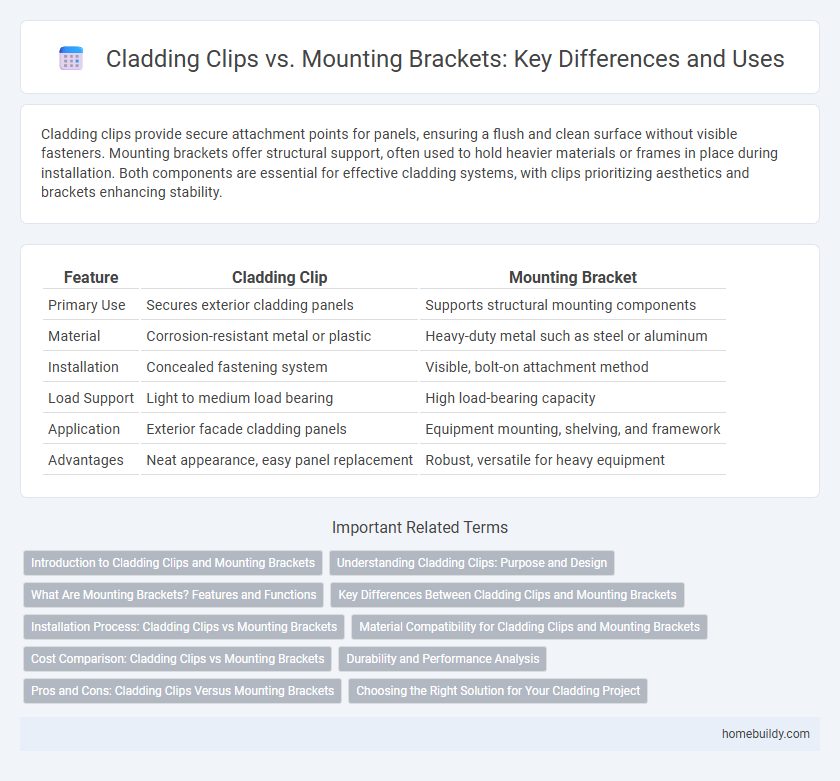Cladding clips provide secure attachment points for panels, ensuring a flush and clean surface without visible fasteners. Mounting brackets offer structural support, often used to hold heavier materials or frames in place during installation. Both components are essential for effective cladding systems, with clips prioritizing aesthetics and brackets enhancing stability.
Table of Comparison
| Feature | Cladding Clip | Mounting Bracket |
|---|---|---|
| Primary Use | Secures exterior cladding panels | Supports structural mounting components |
| Material | Corrosion-resistant metal or plastic | Heavy-duty metal such as steel or aluminum |
| Installation | Concealed fastening system | Visible, bolt-on attachment method |
| Load Support | Light to medium load bearing | High load-bearing capacity |
| Application | Exterior facade cladding panels | Equipment mounting, shelving, and framework |
| Advantages | Neat appearance, easy panel replacement | Robust, versatile for heavy equipment |
Introduction to Cladding Clips and Mounting Brackets
Cladding clips are specialized fasteners designed to securely attach facade panels while allowing for thermal expansion and contraction, ensuring structural integrity and aesthetic appeal. Mounting brackets provide a rigid support framework, often used to anchor cladding systems to the building's structural elements, offering higher load-bearing capacity and alignment precision. Understanding the differences between cladding clips and mounting brackets is essential for selecting the appropriate system based on project requirements such as panel material, wind load, and installation complexity.
Understanding Cladding Clips: Purpose and Design
Cladding clips serve as specialized fasteners designed to securely attach cladding panels to building frames while allowing for thermal expansion and contraction, making them critical for long-term facade stability. Unlike mounting brackets, which provide rigid support and often require more extensive structural integration, cladding clips prioritize flexibility and ease of installation, reducing stress on both the facade and underlying structure. Their design typically includes corrosion-resistant materials and profiles that ensure discreet attachment points, enhancing both aesthetic appeal and weather resistance in contemporary architectural applications.
What Are Mounting Brackets? Features and Functions
Mounting brackets are structural supports designed to securely attach cladding materials to building frameworks, ensuring stability and alignment. They often feature adjustable components for accommodating various panel thicknesses and provide enhanced load distribution to resist wind and seismic forces. Unlike cladding clips, mounting brackets offer greater flexibility in positioning and are integral to creating ventilated facades with improved thermal performance.
Key Differences Between Cladding Clips and Mounting Brackets
Cladding clips provide a discreet fastening solution specifically designed for ventilated facades, allowing for expansion and contraction without visible fixings, while mounting brackets offer robust structural support for heavier cladding systems and typically require direct attachment to the building frame. Cladding clips are often made from corrosion-resistant materials like stainless steel or aluminum, optimized for aesthetic integration and ease of installation, whereas mounting brackets prioritize load-bearing capacity and stability in diverse environmental conditions. The choice between cladding clips and mounting brackets depends on factors such as panel weight, facade design, and thermal movement allowances inherent to the building envelope system.
Installation Process: Cladding Clips vs Mounting Brackets
Cladding clips simplify the installation process by allowing direct attachment to the subframe, reducing the need for extensive pre-drilling and alignment compared to mounting brackets. Mounting brackets require additional components and precise positioning to secure panels, often increasing labor time and complexity. Using cladding clips enhances efficiency by streamlining panel installation and minimizing potential errors during construction.
Material Compatibility for Cladding Clips and Mounting Brackets
Cladding clips are typically made from stainless steel or aluminum, offering superior corrosion resistance and ideal compatibility with metal and composite cladding panels. Mounting brackets, often fabricated from galvanized steel or powder-coated metals, provide robust support but may cause galvanic corrosion if paired with dissimilar metals like aluminum without proper insulation. Selecting the right material compatibility between cladding clips and mounting brackets is crucial to prevent structural degradation and ensure long-term facade integrity.
Cost Comparison: Cladding Clips vs Mounting Brackets
Cladding clips typically offer a more cost-effective solution compared to mounting brackets, primarily due to lower material and installation expenses. Mounting brackets often require additional components and more labor-intensive fitting, leading to higher overall project costs. Choosing cladding clips can reduce both initial outlay and long-term maintenance expenditures in facade installations.
Durability and Performance Analysis
Cladding clips offer superior corrosion resistance and long-term durability compared to traditional mounting brackets, making them ideal for harsh environmental conditions. Their precision-engineered design ensures consistent load distribution and enhanced structural stability, reducing maintenance needs and performance degradation over time. Performance analysis shows cladding clips provide better thermal expansion accommodation and improved facade alignment, critical for high-performance building envelopes.
Pros and Cons: Cladding Clips Versus Mounting Brackets
Cladding clips offer quicker installation and a cleaner aesthetic by providing concealed fixing, reducing visible hardware compared to mounting brackets. However, mounting brackets generally support heavier loads and allow more adjustability for alignment and ventilation gaps in cladding systems. Choosing between cladding clips and mounting brackets depends on the project's structural requirements and desired finishing details.
Choosing the Right Solution for Your Cladding Project
Cladding clips provide a streamlined, invisible fastening method ideal for lightweight panels and modern facades, enhancing aesthetic appeal and reducing installation time. Mounting brackets offer robust support for heavier materials and complex structures, ensuring durability and adaptability in various architectural designs. Selecting between cladding clips and mounting brackets depends on project-specific factors such as material weight, installation speed, and the desired finish quality.
Cladding clip vs Mounting bracket Infographic

 homebuildy.com
homebuildy.com